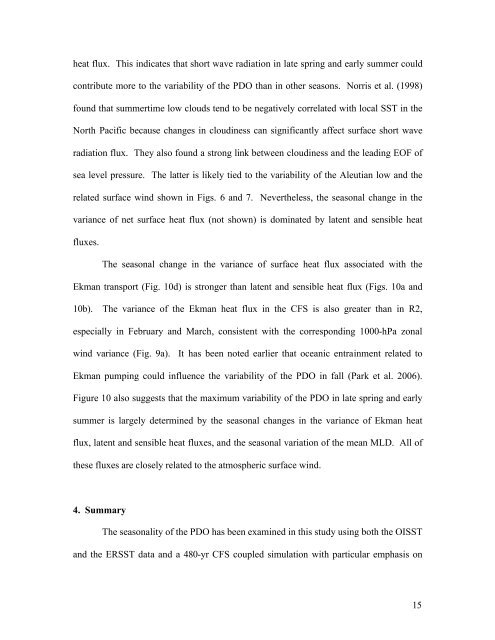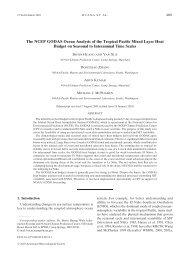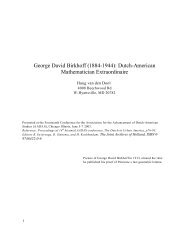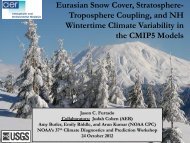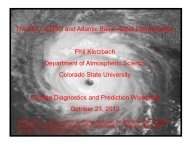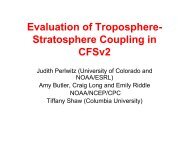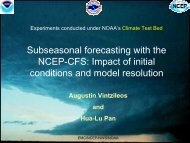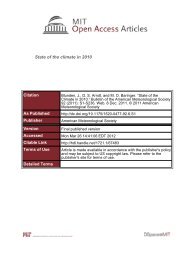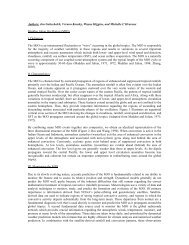Seasonality of the Pacific decadal oscillation - Climate Prediction ...
Seasonality of the Pacific decadal oscillation - Climate Prediction ...
Seasonality of the Pacific decadal oscillation - Climate Prediction ...
You also want an ePaper? Increase the reach of your titles
YUMPU automatically turns print PDFs into web optimized ePapers that Google loves.
heat flux. This indicates that short wave radiation in late spring and early summer could<br />
contribute more to <strong>the</strong> variability <strong>of</strong> <strong>the</strong> PDO than in o<strong>the</strong>r seasons. Norris et al. (1998)<br />
found that summertime low clouds tend to be negatively correlated with local SST in <strong>the</strong><br />
North <strong>Pacific</strong> because changes in cloudiness can significantly affect surface short wave<br />
radiation flux. They also found a strong link between cloudiness and <strong>the</strong> leading EOF <strong>of</strong><br />
sea level pressure. The latter is likely tied to <strong>the</strong> variability <strong>of</strong> <strong>the</strong> Aleutian low and <strong>the</strong><br />
related surface wind shown in Figs. 6 and 7. Never<strong>the</strong>less, <strong>the</strong> seasonal change in <strong>the</strong><br />
variance <strong>of</strong> net surface heat flux (not shown) is dominated by latent and sensible heat<br />
fluxes.<br />
The seasonal change in <strong>the</strong> variance <strong>of</strong> surface heat flux associated with <strong>the</strong><br />
Ekman transport (Fig. 10d) is stronger than latent and sensible heat flux (Figs. 10a and<br />
10b). The variance <strong>of</strong> <strong>the</strong> Ekman heat flux in <strong>the</strong> CFS is also greater than in R2,<br />
especially in February and March, consistent with <strong>the</strong> corresponding 1000-hPa zonal<br />
wind variance (Fig. 9a). It has been noted earlier that oceanic entrainment related to<br />
Ekman pumping could influence <strong>the</strong> variability <strong>of</strong> <strong>the</strong> PDO in fall (Park et al. 2006).<br />
Figure 10 also suggests that <strong>the</strong> maximum variability <strong>of</strong> <strong>the</strong> PDO in late spring and early<br />
summer is largely determined by <strong>the</strong> seasonal changes in <strong>the</strong> variance <strong>of</strong> Ekman heat<br />
flux, latent and sensible heat fluxes, and <strong>the</strong> seasonal variation <strong>of</strong> <strong>the</strong> mean MLD. All <strong>of</strong><br />
<strong>the</strong>se fluxes are closely related to <strong>the</strong> atmospheric surface wind.<br />
4. Summary<br />
The seasonality <strong>of</strong> <strong>the</strong> PDO has been examined in this study using both <strong>the</strong> OISST<br />
and <strong>the</strong> ERSST data and a 480-yr CFS coupled simulation with particular emphasis on<br />
15


